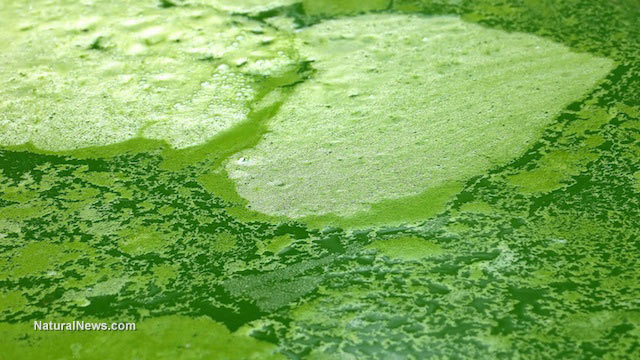 (NaturalNews) Scientists believe that a toxic algae bloom now stretching from California to Alaska could be responsible for poisoning marine mammals across the North American west coast. The bloom is growing in a giant mass of abnormally warm water that has come to be known as “the Blob” and has been positioned off the North American Pacific Coast for several months.
(NaturalNews) Scientists believe that a toxic algae bloom now stretching from California to Alaska could be responsible for poisoning marine mammals across the North American west coast. The bloom is growing in a giant mass of abnormally warm water that has come to be known as “the Blob” and has been positioned off the North American Pacific Coast for several months.
The algae bloom runs from Southern California to Alaska and possibly even to the Aleutian Islands. It is 40 miles wide and reaches 650 feet deep at some points.
“It’s been incredibly thick, almost all the same organism,” said ocean scientist Raphael Kudela of the University of California-Santa Cruz, noting that the bloom “looks like a layer of hay.”
“It’s definitely the largest bloom of this particular algae seen on the West Coast, possibly anywhere, ever.”
Fisheries collapsing
According to the National Oceanic and Atmospheric Administration (NOAA), the bloom is “laced with some toxic [phytoplankton] species that have had far-reaching consequences for sea life and regional and local economies.” These species, known as Pseudo-nitzschia, produce a highly toxic chemical known as domoic acid.
Toxic algae blooms of this variety, also known as red tides, are well known and relatively common. This particular red tide is not only enormous, but it has also been exceptionally long lasting and still shows no signs of dispersing.
“It’s the longest lasting, highest toxicity and densest bloom that we’ve ever seen,” said Vera Trainer, research oceanographer with the Northwest Fisheries Science Center in Washington state.
Clam, crab, anchovy and sardine fisheries in California, Oregon and Washington have all been closed due to population crashes caused by domoic acid poisoning.
“It’s really working its way into the food web and we’re definitely seeing the impacts of that,” Kudela said. He noted that sea lions and pelicans have been sickened from eating domoic acid-tainted prey.
Researchers are also investigating whether the bloom played any role in killing nine fin whales found dead near Kodiak Island, Alaska, in June. Reports of dead and dying whales, gulls and fish in the Aleutian Islands also have scientists worried that the bloom might have spread to that region.
The wide-reaching effects of the red tide led Grist.org to proclaim that the bloom is “basically eating the West Coast alive.”
Read more: (NaturalNews) Scientists believe that a toxic algae bloom now stretching from California to Alaska could be responsible for poisoning marine mammals across the North American west coast. The bloom is growing in a giant mass of abnormally warm water that has come to be known as “the Blob” and has been positioned off the North American Pacific Coast for several months.
The algae bloom runs from Southern California to Alaska and possibly even to the Aleutian Islands. It is 40 miles wide and reaches 650 feet deep at some points.
“It’s been incredibly thick, almost all the same organism,” said ocean scientist Raphael Kudela of the University of California-Santa Cruz, noting that the bloom “looks like a layer of hay.”
“It’s definitely the largest bloom of this particular algae seen on the West Coast, possibly anywhere, ever.”
Fisheries collapsing
According to the National Oceanic and Atmospheric Administration (NOAA), the bloom is “laced with some toxic [phytoplankton] species that have had far-reaching consequences for sea life and regional and local economies.” These species, known as Pseudo-nitzschia, produce a highly toxic chemical known as domoic acid.
Toxic algae blooms of this variety, also known as red tides, are well known and relatively common. This particular red tide is not only enormous, but it has also been exceptionally long lasting and still shows no signs of dispersing.
“It’s the longest lasting, highest toxicity and densest bloom that we’ve ever seen,” said Vera Trainer, research oceanographer with the Northwest Fisheries Science Center in Washington state.
Clam, crab, anchovy and sardine fisheries in California, Oregon and Washington have all been closed due to population crashes caused by domoic acid poisoning.
“It’s really working its way into the food web and we’re definitely seeing the impacts of that,” Kudela said. He noted that sea lions and pelicans have been sickened from eating domoic acid-tainted prey.
Researchers are also investigating whether the bloom played any role in killing nine fin whales found dead near Kodiak Island, Alaska, in June. Reports of dead and dying whales, gulls and fish in the Aleutian Islands also have scientists worried that the bloom might have spread to that region.
Read more: http://www.naturalnews.com/050963_toxic_algae_bloom_Fukushima_Pacific_Ocean.html
